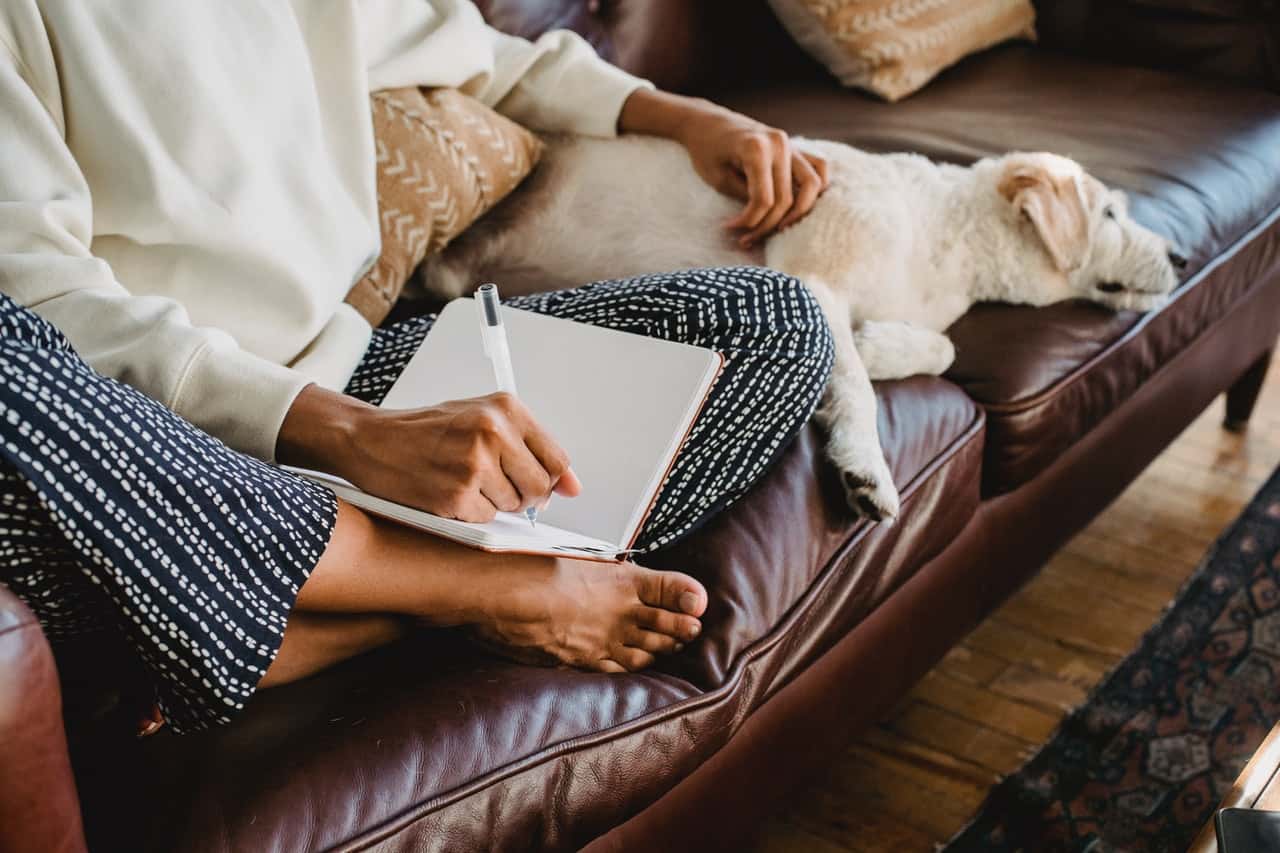Moving and adjusting to apartment life can be sometimes stressful for all parties involved. With that said, many people ignore the stress that moving into a new rental unit puts on pets, especially dogs.
When you downsize from a house to an apartment, it can be sometimes shocking to your pet due to the commotion and noise created. Luckily, there are things you can implement before, during, and after moving to help your pooch adjust to apartment living.
Here, we focus on the critical steps you can take to help your pet adjust easily to living in your apartment.
How to Adjust a Dog to Apartment Living
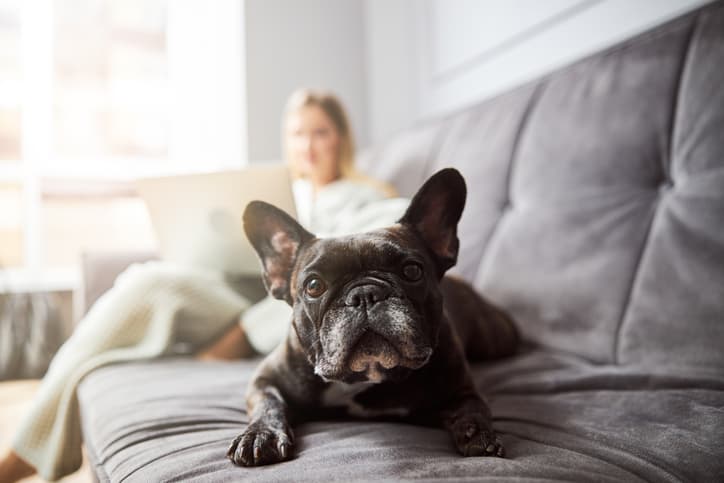
How do you adjust your dog to apartment living? Let’s consider some of the following helpful tips:
Selecting the Perfect Apartment
The best thing you can ever do is select a pet-friendly building, with a favorable apartment pet policy, for your dog. Still, you can have a dog in an apartment that doesn’t support pets, but they must have an emotional service animal document from a mental health provider.
A pet-friendly apartment typically offers additional amenities, like dog parks where you can take your dog for a walk. If you can, go for a rental unit that is on the ground floor for your pooch. Living on the ground floor makes things, like potty breaks, much easier. Also, residing on the ground floor is ideal if you don’t want to annoy your neighbors with noise.
We also recommend going for a carpeted unit since it mutes the sounds from your dog while it’s running and barking. You can also use area rugs if your rental unit has bare floors. Having rugs will also prevent your dogs from slipping, especially when playing.
Before Moving
Even before moving from a house to an apartment, there are things you can do to help your dog adjust quickly to the new environment. This might involve familiarizing yourself with apartment-like surroundings.
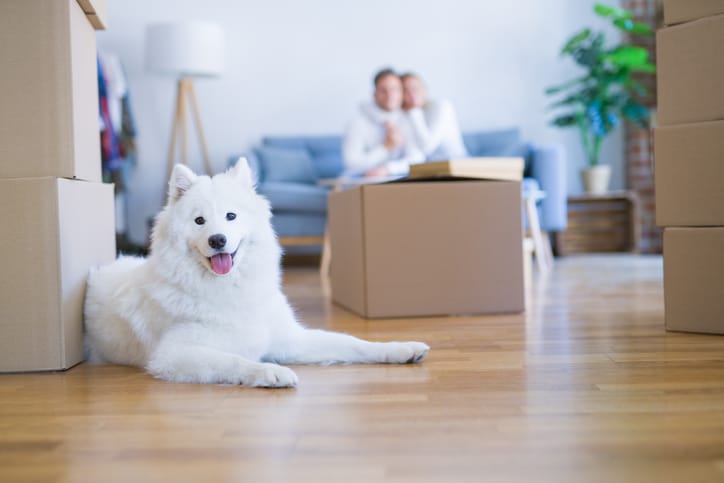
Start Playing with Your Dog Indoors
After moving into an apartment, you won’t get the same space to play with your dog like you would in a fenced yard. It is, therefore, critical that you allow your pet to get used to the indoor playtime even before you move, if possible.
This way, after moving into a rental unit, your dog will adjust more quickly to indoor playtime. You can start by playing games like hide and seek with a ball, bone, or dog toy. You can also play rollover sit tricks. Developing some obstacles for your pooch to navigate can also be helpful.
Visit Your New Apartment
We recommend visiting your future rental unit with your pet more often, especially if it’s not far. This allows your pooch to get used to the smells, sights, and sounds your new apartment presents. Once a dog is familiar with a place, it won’t appear terrified as it would otherwise.
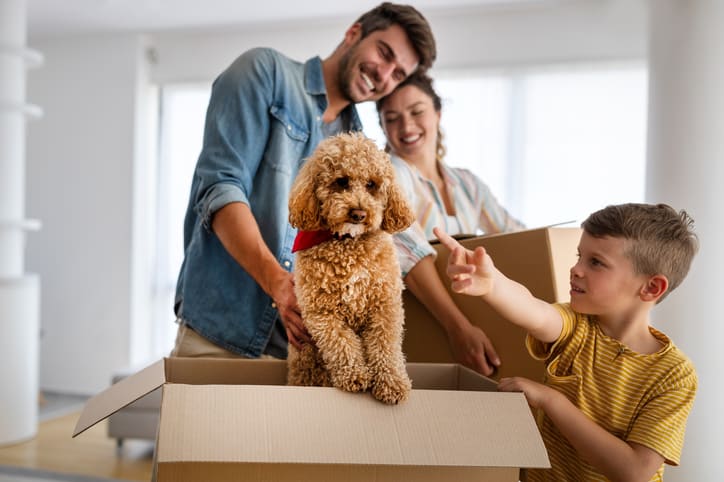
Reduce Outdoor Yard Time
Many apartments don’t offer a lot of outdoor space. Reducing the number of times you take your dog out in the yard allows it to get used to having no yard space. With that said, you need to make the dog’s adjustment gradual to make the transition easier.
We also recommend shortening the time your pet spends outside. For instance, if you used to let your pet play for three hours in the yard, you can reduce the time to about two hours. After about a week, you can then reduce the time to one hour, and so on. Gradual short periods will make a world of difference.
Introducing Training Pads
Before moving to a new rental unit, you need to introduce pads to your dog. These are especially perfect for small dogs.
If you are able to, we recommend laying pads throughout your house in similar positions that you plan to place them within your new rental unit. If you have puppies, we recommend puppy pads, along with baby gates too.
Walk Your Pooch
All dogs, especially younger ones, require exercise. However, the chance to be outside will most likely be reduced in a rental unit.
Having a walk in the morning and evening will give your pet the exercise required. It will also allow your dog to adjust to the new routine once in the rental unit.
Purchase Additional Supplies
Before you move to a rental unit, we recommend that you purchase additional supplies, such as toys and a leash for walks. This way, your pooch will get used to such items even before you move to a rental unit. This will also reduce the pressure of buying items while moving. Remember, the cost of moving is very high, and you wouldn’t want to have to pay for all of these expenses at once.
After Moving
After moving into your new rental unit, there are things you must do to make your dog adjust well.
Give Your Dog Company
Always provide company to your dog in your new apartment until it adjusts. Even if you’re not around, leave your dog with a roommate, family member, partner, or pet sitter for the first few weeks after your move. This way, your pooch won’t feel very anxious.
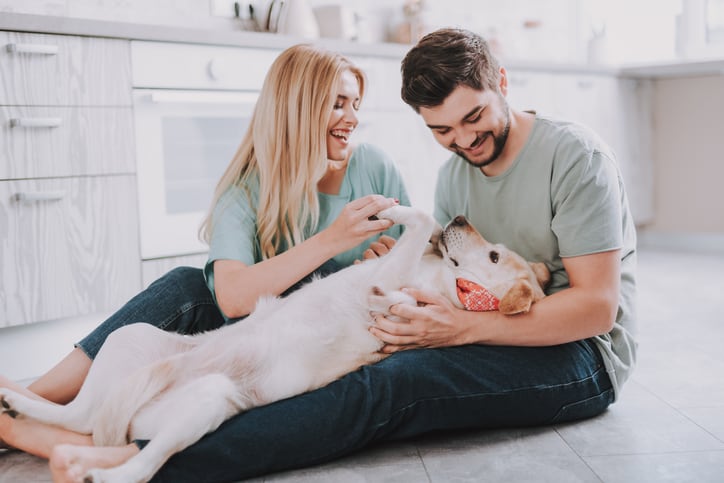
Once your dog shows signs of being comfortable in your new apartment, you can try leaving it alone for some time. To know when your dog is comfortable in the new environment, it will usually hold its tail and ears in a relaxed and natural position, especially when you prepare to leave.
Create a Routine
You should create and establish a routine in the rental apartment immediately. A dog becomes comfortable more quickly in a new space when it understands what to expect.
Have a schedule for everything, including walking and feeding your pet. Ensure you do everything, including playtime, almost at the same time daily, and be disciplined with it.
Develop a Comfortable Environment
Develop a very comfortable environment with things that your pooch can relate to. Having a space where your dog can take a break or get cozy when required helps it feel very comfortable and safe in the new rental unit.
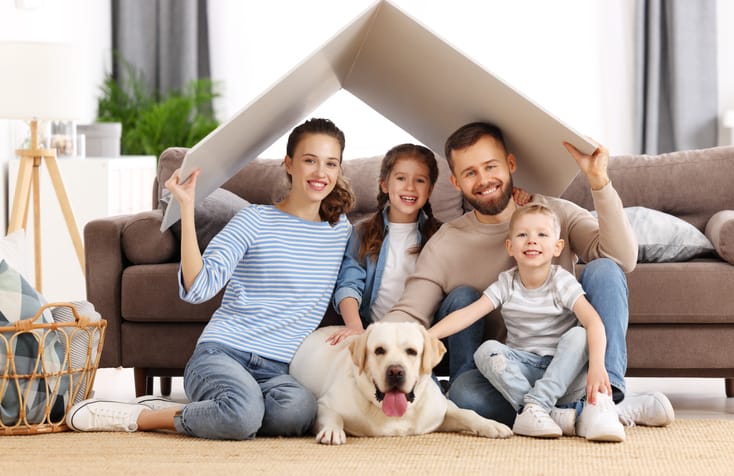
We recommend having familiar blankets and favorite dog toys around. These should be items that the dog was familiar with before moving into the new rental unit. Use the dog’s crate or bed to develop a space purely for the dog.
Expect Behavioral Breakdown
Even when you prepare your dog for a smooth adjustment and transition from a home to a new apartment, they are likely to still feel anxious. This might translate into unwanted behaviors, such as destroying items, sulking under the bed, excessive barking, and forgetting their potty training.
Regressive behaviors are common since dogs naturally assert themselves in new surroundings. They develop separation anxiety in fear of change or being left alone. Such negative behaviors become magnified in a rental unit since many apartment dwellers are affected. In most rental apartments, pet-related destruction is considered an offense, so be sure to learn how to pet-proof an apartment.
Keeping Your Dog Happy
Once you have settled in the rental unit, you must keep your dog happy as much as possible. To achieve this, below are some tips to consider:
Crate Training
Any time you leave your rental unit without your pet, it would help to have your dog in a crate. The crate will help your dog feel more comfortable and less nervous when you leave it alone. You can also take an online crate training course to make the process smoother.
Leave Someone In-Charge
When you’re not at home, especially for extended periods of time, hire someone to take care of your dog. You can consider approaching neighboring pet owners, friends, family members, or even pet experts. A pet expert or pet sitter is always the best option since they understand pets more than anyone else, but know that hiring one will cost you money.
Daily Walks
No matter the dog’s size, you should allow it to have quality time and exercise daily. Since a rental unit typically offers a small space to play and run, we recommend scheduling daily walks as part of your routine.
Ensure you take your dog for a walk at least once, no matter if it’s in the morning, evening, or afternoon, to keep it healthy and active. For each session, walk the dog for about 30 minutes.
Regular Potty Breaks
If you don’t have training pads, we recommend taking your dog out for regular potty breaks. Most dogs require to visit the bathroom at least three times per day. Even if you don’t plan on using indoor pads, take the dog to the bathroom at least once in the morning, noon, and evening.
Use a Dog Park
Apart from daily walks, extensive exercises once every week can also be helpful to your dog. You just need to identify the best and safest parks that are closest to your rental unit. With that said, you will want a park that is perfectly designed for dogs and other pets. Taking your dog out in a park regularly will make it more comfortable in your new rental unit at a much quicker pace.
Daily Indoor Playtime
You need to continue with the indoor playtime program that you introduced your dog to before the move. Indoor playtime will help your dog be comfortable in the new rental unit, and it enables you to bond with your dog while giving it additional exercise.
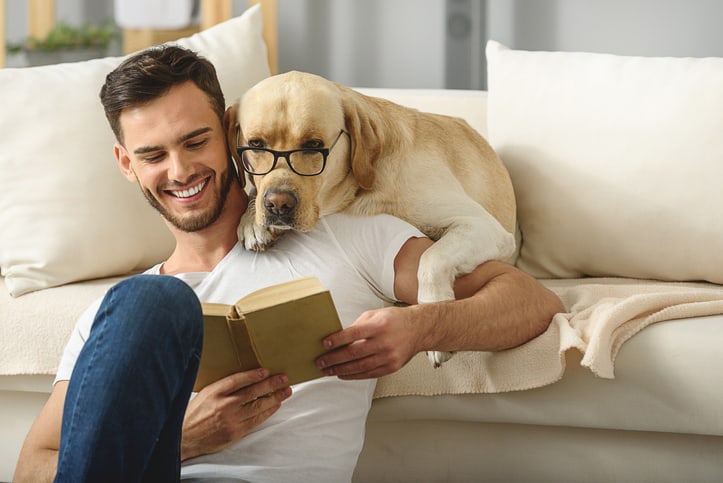
Exposing your dog and allowing it to play with other dogs can also make adjusting easier. Identify a neighbor with a dog in the rental complex and make arrangements for your pets to play together. If you have a small dog, it will help to identify a small pet to play with. A bigger dog can easily overwhelm it, making your dog uncomfortable. The best place to meet other dog owners would be at the park.
Training Your Dog
Most pets, including dogs, are emotionally attached to you and always try to follow your lead. Therefore, you have all the power to make them adjust to apartment living. Due to this, you should train your dog on how to live and adjust to the new environment. Apart from creating a new routine, as we have illustrated above, there are other things you need to do:
Most apartments come with elevators and stairs: This may be something your dog has not experienced before. Therefore, your dog might find it tough to go up and down the stairs at your new rental community.
If they are not used to seeing strangers in a public indoor environment, you might find them doing abnormal things, like barking while getting into elevators. It’s your responsibility to keep your pet close and have them behave as if it’s just a normal ride and not a big deal at all. This is likely to make the dog more comfortable and prevent them from barking.
The bottom line is, the calmer you are, the calmer they will be.
You‘re likely living with neighbors in close proximity: In a rental unit setting, you will likely be closer to neighbors than in a house. This may cause your dog to feel scared when it meets such new neighbors.
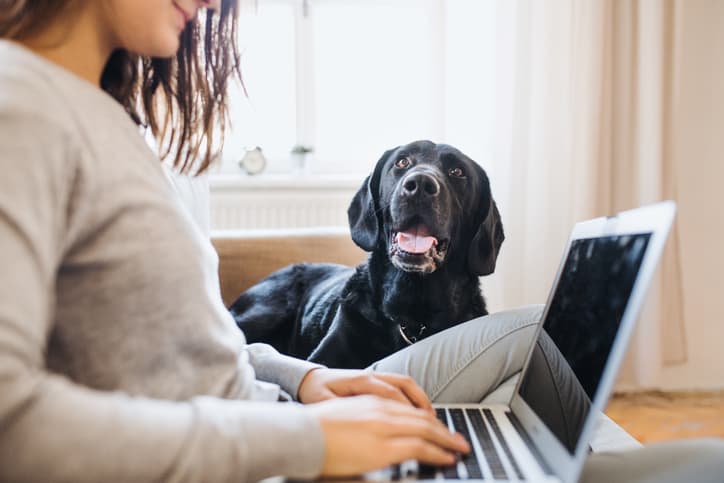
To avoid this, you should introduce your pet to as many neighbors as possible every time you get a chance. Pets, especially dogs, are good at recognizing people’s smell and appearance.
Apartment noises can be too much: You are likely to hear much more noise in your new rental unit compared to a house. These noises may include loud music, the elevator coming down, your neighbor’s dogs barking, people opening and closing their doors, and vehicles.
Most pets, especially dogs, find such noises annoying and uncomfortable. With that said, you can train your pet not to react to such noises and distractions. We recommend distracting your dog with extra treats or by playing with them until it gets used to such noises.

